Success Stories and the Initiatives of the OIC Member States
Islamic Republic of Afghanistan |
|
|
|
|
Kingdom of Morocco |
|
|
|
|
Gambia |
|
|
|
|
Republic of Senegal |
|
|
|
|
Egypt |
|
|
|
|
Republic of Turkey |
|
|
|
|
Guinea |
|
|
|
|
Niger |
|
|
|
|
Senegal-Togo-Bangladesh-Pakistan |
|
|
|
|
Republic of Turkey |
|
|
|
|
United Arab Emirates |
|
|
|
|
Republic of Cameroon |
|
|
|
|
Libya |
|
|
|
|
Burkina Faso |
|
|
Located about 50 km from Bobo-Dioulasso, specifically in the Bama department of the Houet province, the Samendeni Dam, constructed on the Mouhoun River, is the third largest dam in Burkina Faso after the Kompienga and Bagré dams, and the largest in the western region. It has a capacity of 1 billion 50 million cubic meters, with a maximum height of 23.9 meters and a length of 2900 meters. |
|
Senegal |
|
|
Launched in Senegal in 2014, the Water and Sanitation Sector Project ends this December 2024. With $15 million in funding from the African Development Fund, the African Development Bank Group’s concessional window and the Rural Water Supply & Sanitation Initiative, the project has helped improve access to drinking water and sanitation for people in the rural areas of Louga, Kaffrine, and Tambacounda and the cities of Dakar and Ziguinchor. |
|
Uzbekistan |
|
|
The ‘National Policy Framework for Water Governance and Integrated Water Resources Management in Uzbekistan’ programme was a part of the Transboundary Water Management in Central Asia Programme commissioned by the Federal Foreign Office and co-financed by the European Union. Within this project for Uzbekistan, best European practice based on the EU Water Framework Directive was disseminated. |
|
Benin |
|
|
|
|
Cameroon |
|
|
|
|
Cameroon |
|
|
|
|
Gambia |
|
|
|
|
Nigeria |
|
|
|
|
Tunisia |
|
|
|
 The On-Farm Water Management Project (OFWMP) is a project under the World Bank’s Afghanistan Reconstruction Trust Fund (ARTF), providing farmers with improved, reliable, and equitable distribution of irrigation water to increase agricultural productivity and farm incomes and improve food security.
The On-Farm Water Management Project (OFWMP) is a project under the World Bank’s Afghanistan Reconstruction Trust Fund (ARTF), providing farmers with improved, reliable, and equitable distribution of irrigation water to increase agricultural productivity and farm incomes and improve food security.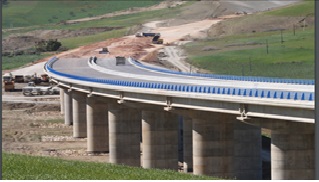 Like other OIC Member States, Morocco has gone through challenging times in achieving sustainable water supply in rural areas. The Taza province of Morocco was facing acute shortage of water supply, a problem confronted by many other provinces and regions of the OIC.
Like other OIC Member States, Morocco has gone through challenging times in achieving sustainable water supply in rural areas. The Taza province of Morocco was facing acute shortage of water supply, a problem confronted by many other provinces and regions of the OIC. The Gambia River is 1,130 kilometers long. It runs through the Republic of Guinea, the Republic of Senegal and the Republic of the Gambia where it meets the Atlantic Ocean. Considering the possibilities offered by the river in terms of resources, the riparian states gradually joined their efforts to develop their relevant economies through different water related projects. At first, the Republic of Senegal and of the Gambia created the Gambia River Basin Development Organization (OMVG) on 30 June 1978 in Kaolack, the Republic of Senegal. Later the Republic of Guinea and the Republic of Guinea-Bissau joined the Organisation respectively in 1981 and 1983.
The Gambia River is 1,130 kilometers long. It runs through the Republic of Guinea, the Republic of Senegal and the Republic of the Gambia where it meets the Atlantic Ocean. Considering the possibilities offered by the river in terms of resources, the riparian states gradually joined their efforts to develop their relevant economies through different water related projects. At first, the Republic of Senegal and of the Gambia created the Gambia River Basin Development Organization (OMVG) on 30 June 1978 in Kaolack, the Republic of Senegal. Later the Republic of Guinea and the Republic of Guinea-Bissau joined the Organisation respectively in 1981 and 1983.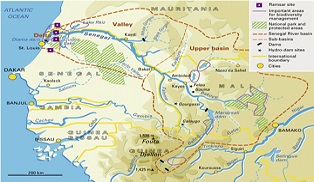 The Senegal River is the third longest river in Africa with 1,800 kilometers. Its source is located in the Fouta Djallon Highlands in the Republic of Guinea and runs through the Republic of Mali, Senegal, and Mauritania where it meets the Atlantic Ocean. Livelihoods of thousands of people depend on it as it is mainly used for the purposes of irrigation, ensuring drinkable water, and energy production.
The Senegal River is the third longest river in Africa with 1,800 kilometers. Its source is located in the Fouta Djallon Highlands in the Republic of Guinea and runs through the Republic of Mali, Senegal, and Mauritania where it meets the Atlantic Ocean. Livelihoods of thousands of people depend on it as it is mainly used for the purposes of irrigation, ensuring drinkable water, and energy production.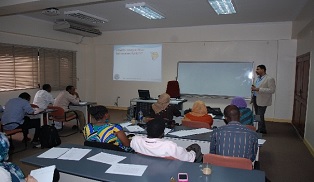 The Regional Training Centre (HRI- RTC) of the Hydraulics Research Institute (HRI) offers specialized training programs at national and regional levels. Since 1996 a three-month diploma course is organized annually for professionals from all Nile Basin countries on “Hydraulic Engineering of River Basins”. Short and tailor made courses on different topics of large interest for the Arab, African or Nile Basin countries are also organized each year.
The Regional Training Centre (HRI- RTC) of the Hydraulics Research Institute (HRI) offers specialized training programs at national and regional levels. Since 1996 a three-month diploma course is organized annually for professionals from all Nile Basin countries on “Hydraulic Engineering of River Basins”. Short and tailor made courses on different topics of large interest for the Arab, African or Nile Basin countries are also organized each year. 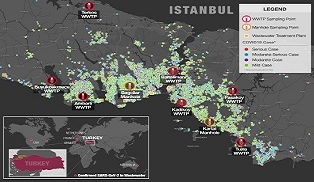 Turkish Water Institute (SUEN) in collaboration with the General Directorate of State Hydraulic Works (DSI), General Directorate of Food and Control, General Directorate of Water Management and Marmara University Environmental Engineering Department, conducted a scientific research to monitor the presence of the novel coronavirus (SARS-CoV-2) in wastewaters in Turkey.
Turkish Water Institute (SUEN) in collaboration with the General Directorate of State Hydraulic Works (DSI), General Directorate of Food and Control, General Directorate of Water Management and Marmara University Environmental Engineering Department, conducted a scientific research to monitor the presence of the novel coronavirus (SARS-CoV-2) in wastewaters in Turkey.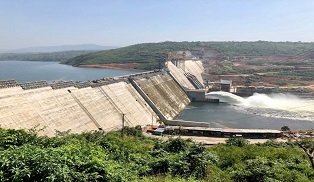 Souapiti is located on the Konkoure River near Conkary. The project is a result of the government of President Alpha Condé’s commitment to use hydropower to improve access to electricity. Reliable access to electricity to all social classes’ remains challenging to this country nicknamed “Africa's water tower”. The rate of electricity access was estimated at 29 percent in 2017, which is below that year’s average for sub-Sahara Africa of 43 percent.
Souapiti is located on the Konkoure River near Conkary. The project is a result of the government of President Alpha Condé’s commitment to use hydropower to improve access to electricity. Reliable access to electricity to all social classes’ remains challenging to this country nicknamed “Africa's water tower”. The rate of electricity access was estimated at 29 percent in 2017, which is below that year’s average for sub-Sahara Africa of 43 percent.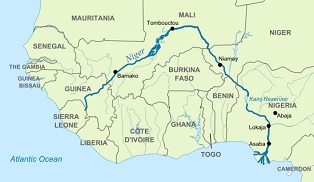 The Niger River is the third longest in Africa with 4,200 kilometres after the Nile and the Congo. The basin area is about 2.2 million square kilometres encompassing more than 150 million people. The river crosses several countries, including Guinea, Cote d’Ivoire, Mali, Niger, Burkina Faso, Benin, Cameroon, Chad, and Nigeria, which are members of the Organisation of Islamic Cooperation (OIC). Most of the areas are characterised by low rainfall, dry and arid desert, making it crucial for sustaining people life and the ecosystem.
The Niger River is the third longest in Africa with 4,200 kilometres after the Nile and the Congo. The basin area is about 2.2 million square kilometres encompassing more than 150 million people. The river crosses several countries, including Guinea, Cote d’Ivoire, Mali, Niger, Burkina Faso, Benin, Cameroon, Chad, and Nigeria, which are members of the Organisation of Islamic Cooperation (OIC). Most of the areas are characterised by low rainfall, dry and arid desert, making it crucial for sustaining people life and the ecosystem. The Islamic Development Bank (IsDB) provides support to its Member Countries in various sectors, including Agriculture, Education, Energy, Finance, Health and Social Services, Industry and Mining, Information and Communications, Public Administration, Real Estate, Trade, Transport, and Water, Sanitation and Urban. These sector-based projects are implemented in collaboration with the Member Countries along with other partners to ensure knowledge transfer, sharing of best practices for greater impact, and successful delivery of innovative solutions to development challenges.
The Islamic Development Bank (IsDB) provides support to its Member Countries in various sectors, including Agriculture, Education, Energy, Finance, Health and Social Services, Industry and Mining, Information and Communications, Public Administration, Real Estate, Trade, Transport, and Water, Sanitation and Urban. These sector-based projects are implemented in collaboration with the Member Countries along with other partners to ensure knowledge transfer, sharing of best practices for greater impact, and successful delivery of innovative solutions to development challenges. Turkish Water Institute (SUEN) and Marmara University of Istanbul created WWCovid platform on Slack (wwcovid.slack.com). This platform has been created as part of a nationwide SARS-CoV-2 surveillance study in the wastewater treatment plants of Turkey under the leadership of the Ministry of Agriculture and Forestry of the Republic of Turkey.
Turkish Water Institute (SUEN) and Marmara University of Istanbul created WWCovid platform on Slack (wwcovid.slack.com). This platform has been created as part of a nationwide SARS-CoV-2 surveillance study in the wastewater treatment plants of Turkey under the leadership of the Ministry of Agriculture and Forestry of the Republic of Turkey. Within the framework of the Ministry of Climate Change & Environment's strategy 2017-2021 for the sustainability of natural ecosystem and preserving marine life, the Ministry is rehabilitating the degraded coastal areas through the restoration of coral reefs, which are considered as natural habitat and multi-dimension community structure for marine organisms, the cultivation of mangroves which provide nursery and feeding ground for many living organisms, in addition to deploying artificial reefs to support the marine environment. The goals of the initiative are: To enhance marine habitat areas in the UAE, to promote biodiversity (species & habitat) in UAE marine and coastal areas and to enhance sustainability of marine ecosystem.
Within the framework of the Ministry of Climate Change & Environment's strategy 2017-2021 for the sustainability of natural ecosystem and preserving marine life, the Ministry is rehabilitating the degraded coastal areas through the restoration of coral reefs, which are considered as natural habitat and multi-dimension community structure for marine organisms, the cultivation of mangroves which provide nursery and feeding ground for many living organisms, in addition to deploying artificial reefs to support the marine environment. The goals of the initiative are: To enhance marine habitat areas in the UAE, to promote biodiversity (species & habitat) in UAE marine and coastal areas and to enhance sustainability of marine ecosystem. With a capacity of 420 MW, Nachtigal hydropower plant is the largest hydroelectric production project in Cameroon. This strategic project is being developed by a Cameroonian company, the Nachtigal Hydro Power Company (NHPC). Its shareholders include Electricité de France (EDF), the State of Cameroon and the International Finance Corporation (IFC). While operations are expected to begin in 2023, the project is expected to increase Cameroon’s power generation capacity by 30% and reduce annual generation costs by $100 Million.
With a capacity of 420 MW, Nachtigal hydropower plant is the largest hydroelectric production project in Cameroon. This strategic project is being developed by a Cameroonian company, the Nachtigal Hydro Power Company (NHPC). Its shareholders include Electricité de France (EDF), the State of Cameroon and the International Finance Corporation (IFC). While operations are expected to begin in 2023, the project is expected to increase Cameroon’s power generation capacity by 30% and reduce annual generation costs by $100 Million. The Great Man-Made River (GMMR), is a network of underground pipelines that brings high-quality fresh water from ancient underground aquifers deep in the Nubian Sahara to all Libyan cities for domestic, agriculture, and industry use. It was established in 1983 and it is considered the world's largest irrigation project.
The Great Man-Made River (GMMR), is a network of underground pipelines that brings high-quality fresh water from ancient underground aquifers deep in the Nubian Sahara to all Libyan cities for domestic, agriculture, and industry use. It was established in 1983 and it is considered the world's largest irrigation project.


 In Cotonou, Benin's economic capital, major stormwater drainage works have transformed the face of several neighborhoods that once were victims of flooding.With support from the Cotonou rainwater sanitation program, financed by a pool of partners including the World Bank, kilometers of drains, paved roads, and gutters have been built, as well as seven water retention basins.
In Cotonou, Benin's economic capital, major stormwater drainage works have transformed the face of several neighborhoods that once were victims of flooding.With support from the Cotonou rainwater sanitation program, financed by a pool of partners including the World Bank, kilometers of drains, paved roads, and gutters have been built, as well as seven water retention basins. In Cameroon, a new wave of aquaculture development is improving incomes and food security through the Livestock and Fish Farming Value Chain Development Project, financed by the African Development Bank and implemented with the Ministry of Livestock, Fisheries and Animal Industries.
In Cameroon, a new wave of aquaculture development is improving incomes and food security through the Livestock and Fish Farming Value Chain Development Project, financed by the African Development Bank and implemented with the Ministry of Livestock, Fisheries and Animal Industries. In 2025, Douala advanced safe drinking water access through a WHO-supported community governance model. Beginning in the Brazzaville neighborhood during a cholera outbreak, the city established locally managed Water Management Committees, trained residents in WASH practices, and rehabilitated water points.
In 2025, Douala advanced safe drinking water access through a WHO-supported community governance model. Beginning in the Brazzaville neighborhood during a cholera outbreak, the city established locally managed Water Management Committees, trained residents in WASH practices, and rehabilitated water points. A climate-smart rural WASH initiative, supported by the African Development Bank and the Global Environment Facility, has improved access to clean water for over 110,000 people across 144 villages in The Gambia. Solar-powered boreholes, public taps, and new sanitation facilities have replaced long walks to unsafe wells, easing the daily burden on women and girls.
A climate-smart rural WASH initiative, supported by the African Development Bank and the Global Environment Facility, has improved access to clean water for over 110,000 people across 144 villages in The Gambia. Solar-powered boreholes, public taps, and new sanitation facilities have replaced long walks to unsafe wells, easing the daily burden on women and girls. With support from the African Development Bank, the Port Harcourt Urban Water Sector Reform and Water Supply & Sanitation Project has achieved major progress toward restoring reliable urban water services. The project has delivered infrastructure capable of treating and distributing 140,000 m³ of water per day across Port Harcourt and Obio/Akpor, now 99.9% complete.
With support from the African Development Bank, the Port Harcourt Urban Water Sector Reform and Water Supply & Sanitation Project has achieved major progress toward restoring reliable urban water services. The project has delivered infrastructure capable of treating and distributing 140,000 m³ of water per day across Port Harcourt and Obio/Akpor, now 99.9% complete. In northern Tunisia’s Sejnane region, rural households that once relied on wells and springs now have reliable drinking water thanks to the Rural Drinking Water Supply Programme, financed by the African Development Bank and implemented by the Ministry of Agriculture, Water Resources and Fisheries.
In northern Tunisia’s Sejnane region, rural households that once relied on wells and springs now have reliable drinking water thanks to the Rural Drinking Water Supply Programme, financed by the African Development Bank and implemented by the Ministry of Agriculture, Water Resources and Fisheries.